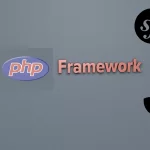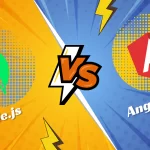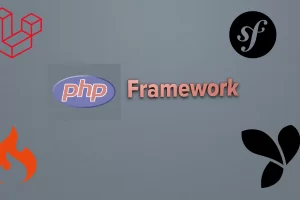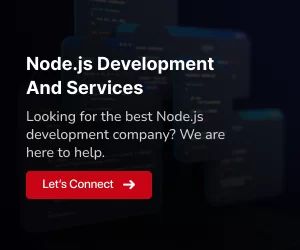In the ever-evolving landscape of web development, React stands tall as a cornerstone for creating engaging and dynamic user interfaces. As we step into 2024, harnessing the power of React necessitates a solid foundation at the backend. This article embarks on a journey to discover the top backend technologies for React in 2024 that promise to elevate your web applications to new heights.
The backend, often referred to as the server-side of a web application, plays a pivotal role in ensuring smooth communication, managing databases, and empowering the application’s core functionality. When expertly paired with React, a robust backend enhances an application’s performance, scalability, security, and overall user experience.
In this exploration, we will unravel the crucial backend technologies that synergize seamlessly with React, providing the foundation for a robust, efficient, and scalable application. From established frameworks to emerging players, we will dissect their merits and demystify their potential, enabling you to make an informed decision in selecting the best backend technology for your React project.
So, let’s embark on this enlightening journey through the realm of backend technologies, shedding light on the best companions for React as we stride into the promising year of 2024. Stay tuned for a comprehensive understanding of how the right backend can fuel your React-powered applications to thrive in the digital realm.
The Evolution of Web Development: A Glimpse into the Future
In the ever-changing world of web development, staying ahead of the curve is not just a choice but a necessity. As we stand on the cusp of 2024, the dynamics of web development are evolving at an unprecedented pace. The demand for interactive, responsive, and feature-rich web applications continues to surge, driving developers to explore innovative technologies and frameworks.
React, developed by Facebook, has emerged as a frontrunner in the realm of front-end development. Its component-based architecture, virtual DOM, and efficient rendering have revolutionized the way web applications are built. However, to unlock the true potential of React and ensure a seamless user experience, an equally
Exploring the Top Backend Development Frameworks
As we step into 2024, the synergy between React, a dominant force in front-end development, and backend technologies is more pivotal than ever. The backend serves as the engine that propels the application, ensuring seamless communication, data management, and robust functionality.
In this dynamic landscape, the importance of selecting the top backend technologies for React cannot be overstated. The right backend technology not only complements React’s capabilities but significantly impacts the application’s speed, scalability, and overall efficiency.
In this article, we embark on an exploration to unveil the finest backend frameworks that harmonize with React, elevating your web applications to new heights. We will delve into the features and advantages of these technologies, empowering you to make informed decisions for your projects in 2024. Stay tuned for a comprehensive guide to navigate the fusion of React with the finest backend technologies, propelling your applications towards success.
The Power of Ruby on Rails: A Comprehensive Insight
Ruby on Rails, commonly known as Rails, is an open-source web application framework rooted in the Ruby programming language. Renowned for its developer-friendly environment and rapid development capabilities, Rails thrives on the principles of convention over configuration and the “Don’t Repeat Yourself” (DRY) approach. This framework expedites project development by minimizing redundant code through standardized conventions, enabling quick transitions from planning to execution.
What sets Rails apart is its modular design and scalability. Developers can compartmentalize complex applications into manageable components, ensuring smooth scalability as traffic and data volumes grow. The extensive library of pre-built functionalities, known as gems, further accelerates development. Supported by a vibrant and active community, Rails prioritizes developer satisfaction, emphasizing clean, readable code and built-in security features to create a robust and secure web application development experience.
Also Read: The Best Back-End Tools for US Developers to Use in 2024
Discovering the Beauty of Laravel: A Journey into Modern PHP Development
Laravel, a PHP web application framework, stands as a testament to refined craftsmanship in the world of modern web development. Boasting elegance, efficiency, and innovation, Laravel has redefined PHP programming, making it an absolute pleasure for developers. At its core lies a powerful foundation that streamlines intricate tasks, empowering developers to build scalable and feature-rich applications seamlessly.
One of Laravel’s standout features is Eloquent Object-Relational Mapping (ORM). Eloquent simplifies database interactions by employing an advanced implementation of the active record pattern. Developers can now interact with databases using an expressive and familiar syntax, enhancing code readability and productivity. Additionally, Laravel’s Blade templating engine adds to its allure, offering an intuitive and efficient way to manage templates. With features like template inheritance and control structures, Blade makes the view layer of applications both elegant and easy to work with, contributing to a delightful development experience.
Savoring CakePHP: A Taste of Effortless PHP Web Development
CakePHP, a savory PHP web application framework, entices developers with its blend of simplicity and productivity. Leveraging conventions over configuration, it streamlines development via its “bake” console, promoting a concise and predictable codebase. This efficient approach reduces coding efforts, making application development a delightful experience.
CakePHP places security at the forefront by embedding essential features like CSRF protection and SQL injection prevention. Its built-in security measures help developers create applications with a strong shield against potential vulnerabilities. Simultaneously, the intuitive Object-Relational Mapping (ORM) simplifies database interactions, facilitating seamless data management. CakePHP’s sweet spot lies in its ability to provide efficient development and security, making it a delectable choice for PHP developers.
Exploring Django’s Perfection: A Dive into Python Web Development
Django, a Python-based web framework, epitomizes modern web development’s finesse. Its elegance, efficiency, and robustness have elevated it to the pinnacle of developer preferences. Unveiling Django’s excellence, we delve into the attributes that set it apart in the web development landscape.
Django’s “batteries-included” philosophy provides an extensive toolkit right out of the box, covering authentication, database management, templating, and routing. This comprehensive suite equips developers to commence projects swiftly, significantly reducing development time and complexity. Additionally, Django’s high-level abstractions simplify intricate tasks, particularly through its seamless Object-Relational Mapping (ORM) system, further enhancing its allure in the Python web development domain.
Springing into Action: A Quickstart Guide to Spring Boot
Embarking on Spring Boot is a swift journey. Begin by utilizing Spring Initializr, a web tool that quickly generates a Spring Boot project structure with chosen configurations. Define your project details, desired Spring Boot version, add necessary dependencies like Spring Web for web application development, and download the generated project in a convenient zip file.
Once downloaded, unzip and open the project in your favorite IDE. The project adheres to a standard Maven or Gradle layout. Configure application properties in application.properties or application.yml, covering aspects like server port, database settings, or custom application properties. This setup forms the basis for leveraging Spring Boot’s efficiency and power to craft robust Java-based web applications.
Flask: A Python Microframework Packed with Potential
Flask, a Python microframework, packs a punch in web development. Despite its minimalist approach, Flask is potent and versatile, offering a robust foundation for creating web applications, APIs, and complex systems. In this concise guide, we’ll uncover how Flask enables rapid and efficient Python web development.
Flask embraces its ‘micro’ identity, keeping things simple and effective. Its lightweight core and uncomplicated interface make it easy to understand and apply. Both beginners and seasoned developers appreciate Flask’s straightforwardness, making it a go-to choice for swift development.
Express.js: Streamlining Node.js Web Development
Express.js, a robust and flexible web application framework for Node.js, simplifies backend development. It provides a minimalistic yet powerful platform that allows developers to build scalable and efficient server-side applications. This guide offers a glimpse into how Express.js accelerates Node.js web development, making it a popular choice among developers.
Express.js stands out for its lightweight design and flexibility. It offers a myriad of features and middleware that can be easily integrated to extend its capabilities. Developers have the freedom to structure their applications according to their preferences, making it a versatile choice for a wide range of projects. The simplicity of Express.js expedites the development process, making it an excellent fit for both small-scale applications and large-scale enterprise projects.
These top backend development frameworks provide a diverse range of options, catering to different project requirements and developer preferences. Assessing the specific needs of your React application and understanding the strengths of each framework will help you make an informed decision.
Evaluating Criteria for the Best Backend Framework
Choosing the top backend technology for React entails considering various criteria to ensure a seamless integration and optimal performance. Let’s outline some essential factors to evaluate when making this critical decision.
Performance and Scalability:
Performance and scalability are pivotal aspects of a framework. Express.js, with its asynchronous and event-driven architecture, ensures rapid request handling without blocking I/O. Scalability is achieved through load distribution, allowing applications to efficiently handle a surge in users by utilizing clustering or load balancing techniques, maintaining optimal response times even during peak usage.Compatibility with React:
Seamless integration with React is a vital aspect of backend technology. Express.js, with its flexibility and structure, integrates effortlessly with React’s component-based architecture. It allows for the smooth flow of data between the backend and the React application, enhancing the overall performance and user experience. Express.js provides an ideal backend foundation that aligns perfectly with React, facilitating efficient development and a cohesive development workflow.Community Support and Documentation:
An active and supportive community is pivotal for the success of any backend technology. Express.js boasts a thriving community, offering extensive support, documentation, and a rich ecosystem of plugins and middleware. The community actively contributes to updates, patches, and enhancements, ensuring developers have access to the latest tools and resources. Moreover, comprehensive documentation serves as a valuable asset, providing developers with guidelines, tutorials, and best practices, fostering a strong and knowledgeable community around Express.js.Security:
Security is a non-negotiable aspect when selecting a backend technology. Express.js prioritizes security by implementing various measures to protect against common vulnerabilities. It includes built-in middleware and features like helmet.js, which helps secure the application by setting appropriate HTTP headers. Express.js encourages best security practices, safeguarding against threats like cross-site scripting (XSS), SQL injection, and other potential risks, making it a reliable choice for developing secure backend systems.Flexibility and Customization:
Express.js offers exceptional flexibility, allowing developers to customize and tailor their backend according to project requirements. The framework provides a modular and minimalist approach, allowing developers to pick and choose the functionalities they need, enhancing project adaptability. Developers can integrate various middleware, libraries, and extensions as per their specific use cases, enabling them to create a backend that perfectly fits their application’s unique needs.Learning Curve:
Choosing a backend technology with a manageable learning curve is essential. Express.js, with its simplicity and intuitive design, offers a relatively gentle learning curve. Developers familiar with JavaScript can quickly adapt to Express.js, minimizing the time needed for training and onboarding. Moreover, if your team already has proficiency in Node.js, transitioning to Express.js becomes even smoother, aligning with existing skills and expertise. This ensures a rapid integration of Express.js into your development stack and a quicker time-to-market for your applications.
Also Read: Top Node.js development companies in the US
Conclusion
Selecting the right backend technology is pivotal for the success of any web application. GeekyAnts, a leading software development company, has leveraged these top backend technologies for React in numerous client projects, showcasing their prowess in crafting efficient and scalable web applications. In our exploration of Express.js, we’ve witnessed its prowess in addressing critical factors such as performance, scalability, compatibility with React, security, flexibility, and ease of learning. Express.js stands out for its ability to efficiently handle a growing user base while seamlessly integrating with React, ensuring optimal application performance and an enhanced user experience.
Moreover, Express.js offers a gentle learning curve, making it accessible for developers, especially those already familiar with JavaScript and Node.js. Its active community support and comprehensive documentation further contribute to a developer-friendly environment. As you embark on your web development journey, considering the strengths of Express.js can lead to a well-informed decision, paving the way for the creation of robust and efficient web applications.















